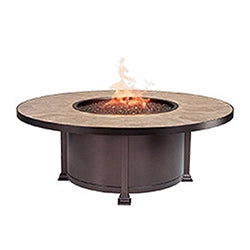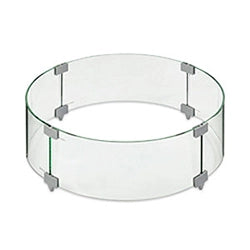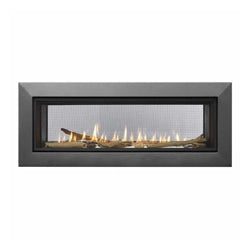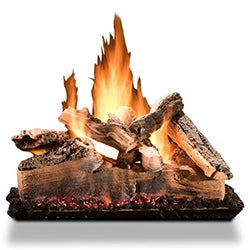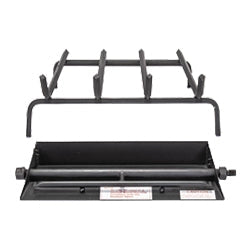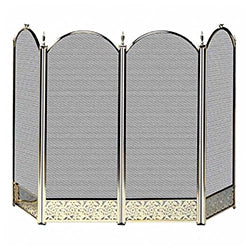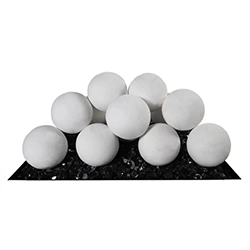If you are considering building an outdoor DIY fire pit project, it is important to understand some of the design aspects that play an integral role in its functionality. Fire pits rely on their environment to initiate and sustain combustion. In this article, we discuss the importance of ventilation requirements—an often overlooked feature—in wood and gas burning fire pits.
What Is Combustion?
 Fire pits need ample ventilation to achieve proper combustion. [Pictured from left to right: Manta Ray Fire Pit, Magnum Fire Pit, Funky Dog Fire Pit, Scallop Fire Pit by Fire Pit Art.]
Fire pits need ample ventilation to achieve proper combustion. [Pictured from left to right: Manta Ray Fire Pit, Magnum Fire Pit, Funky Dog Fire Pit, Scallop Fire Pit by Fire Pit Art.]
First, we'll go over the fundamentals of combustion that will help explain the need for ventilation. What is combustion? It is the process of burning that requires air, fuel, and heat. Each element needs to be equally present for it to occur. If there is an improper supply of any component, the desired combustion, called complete combustion in the industry, will cease. Instead, incomplete combustion will occur. This type of combustion is incredibly dangerous—it produces an odorless, toxic byproduct called carbon monoxide. Incomplete combustion may also cause rapid, uncontrolled burning or even pressure buildup that can result in an explosion. With the basic principles of combustion in mind, we will go more into depth about how this relates to ventilation.
Why Is It Important to Meet Ventilation Requirements?
 Improve air flow for your DIY gas fire pit project with a Decorative Fire Pit Venting Panel in Arbor by Starfire Designs.
Improve air flow for your DIY gas fire pit project with a Decorative Fire Pit Venting Panel in Arbor by Starfire Designs.
Regardless of size, shape, or fuel, your fire pit should be installed in a well-ventilated area to aid in optimal performance. As mentioned before, air plays a key role in the combustion process—both for air intake and outtake. Successful operation of your fire pit means air involvement in the initial combustion as well as at the end, to assist in releasing excessive heat and gas residue.
Take for instance the design of a wood burning fire pit that comprises of a simple shell enclosure. The firewood located within the burn area rely on open, well-ventilated spaces to be able to pull oxygen in to initiate combustion. The fire pit should meet clearance and ventilation requirements to not only sustain combustion, but to remove combustion byproducts and heat.
Likewise, fire pits running on propane gas are required to have a vent installed lower on the enclosure, as well as an air mixer that works in conjunction to the vent. Since propane gas is heavier than air, it will sink and pool to the floor. Should the gas accumulate at the bottom and ignite, it can explode and cause injury to property and life. To prevent gas from collecting at the base of the fire pit, a vent opening is required to remove excess heat, release pressure buildup, and allow gas to escape.
The air mixer—which is connected to the gas flex line and burner pan—relies on the vent opening as a source for drawing outdoor combustion air inside the enclosure. It has air hole openings designed specifically for diluting the gas, as well as providing a cleaner, more efficient burning flame for safe operation. The use of an air mixer along with proper ventilation ensures complete combustion is regularly achieved. In the event of a gas leak, for instance, the vent will help any residual fuel or pressure buildup escape.
While you may notice that some fire pits running on propane gas may not have a vent, this is typically because leveling feet have been installed beneath the enclosure. This construction feature is designed purposefully to lift your fire feature off from the ground for—you guessed it—ventilation. Any gas fire pit that does not have a vent, nor a gap at the base, is at high risk for explosion.
Although natural gas is lighter than air, proper ventilation is still required to prevent the risk of a gas leak accumulating inside the enclosure. It's important to follow the manufacturer's instructions for venting requirements to prevent poor performance, voiding your fire pit's warranty, and minimizing damage to property and life.
Building a DIY fire pit project? Here are some other guides you may find helpful:
Ventilation is crucial for promoting efficient air flow and removing combustion byproducts. Installing a fire pit in an enclosed space, choking the air with too much fire media over the burner, or blocking the vent's air passageways can affect its functionality. With clearance and ventilation requirements met, you can improve safety and reduce liability situations. Again, it is important to follow the manufacturer's venting requirements.
For any additional questions on this product—or for expert help on any project—feel free to contact our friendly and knowledgeable staff by filling out this simple form.
Main image: Decorative Fire Pit Venting Panel in Mosaic by Starfire Designs







